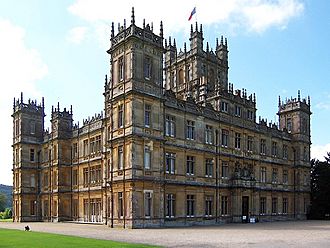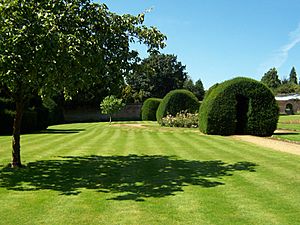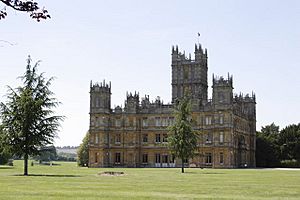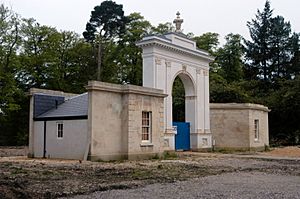Highclere Castle facts for kids
Quick facts for kids Highclere Castle |
|
|---|---|

Façade
|
|
| General information | |
| Status | Grade I listed |
| Type | Stately home |
| Architectural style | Jacobethan ("Jacobean Revival") |
| Location | Highclere, Hampshire |
| Coordinates | 51°19′36″N 1°21′41″W / 51.326667°N 1.361389°W |
| Completed | 1679 |
| Renovated | 1842–49 |
| Owner | George Herbert, 8th Earl of Carnarvon |
| Other information | |
| Number of rooms | 300 |

Highclere Castle is a famous country house in Hampshire, England. It was first built in 1679 and then greatly changed in the 1840s. The castle sits on a huge estate of about 5,000 acres (2,023 hectares). Its beautiful park was designed by the famous landscape architect Capability Brown in the 1700s.
Highclere Castle is the family home of the Earls of Carnarvon. It has become very well known around the world. This is because it was the main filming location for the popular TV show Downton Abbey (2010–2015) and the movie based on it.
Today, you can visit Highclere Castle, its Egyptian exhibition, and the gardens. They are open to the public during the summer and at other special times of the year, like Christmas. The castle also hosts fun events, such as concerts and special guided tours.
Contents
History of Highclere Castle
Early Days of the Estate
The first records of the Highclere estate date back to the year 749. An Anglo-Saxon king gave the land to the Bishops of Winchester. The original site was also mentioned in the Domesday Book, a very old survey of England.
In the late 1300s, Bishop William of Wykeham built a grand medieval palace and gardens here. This was the bishop's home in the park.
Royal Visits and Changes
King Edward II visited the bishop at Highclere on September 2, 1320.
Later, in 1551, during a time called the Protestant Reformation, King Edward VI took the property from the Church of England.
New Owners and Designs
After being owned by a few different families, Highclere Castle was bought by Sir Robert Sawyer in 1679. He was a lawyer and an important government official called the Attorney General. Sir Robert rebuilt the palace, calling it Highclere Place House.
His daughter, Margaret, inherited the mansion. Her grandson, Robert Sawyer Herbert, started the castle's famous portrait collection. He also created some of the garden temples. His nephew, Henry Herbert, was later given the title of Earl of Carnarvon by King George III.
The Pococke Family and Cedars
The Pococke family had a connection to Highclere. Reverend Richard Pococke (1704–1765) was educated at the Highclere rectory. He became a bishop and a famous travel writer.
Bishop Pococke was one of the first people to bring Cedar of Lebanon seeds to England. He collected them during his travels in Lebanon in 1738. Some of these seeds grew into the beautiful cedar trees you can see at Highclere today.
The 19th Century Remodel
In the 1800s, Highclere Castle was a square, classical building. But it was completely redesigned and rebuilt between 1842 and 1849. This work was done for the third Earl of Carnarvon by Sir Charles Barry. Barry was also the architect who designed the Houses of Parliament in London.
Barry designed Highclere in the Jacobethan style. This style mixes elements of Elizabethan and Jacobean architecture from the late 1500s and early 1600s. The outside of the castle is made of Bath stone. Barry also added some Italian-style features, especially to the tall, slender towers.
Even though the outside was finished quickly, the inside and the west wing (for servants) took longer. Thomas Allom, who worked with Barry, finished the interior of the castle in 1878.
The Founding of Canada
Highclere Castle played a surprising role in the founding of a country! In the 1860s, the 4th Earl of Carnarvon worked on the British North America Act of 1867 at the castle. He worked with important Canadian leaders like John A. Macdonald, who later became the first Prime Minister of Canada.
This Act led to the creation of the nation of Canada. To remember this, a maple tree was planted on the castle lawn in 2018.
Highclere in the 20th Century
The castle became home to amazing Egyptian artifacts. This happened because the 5th Earl of Carnarvon loved studying ancient Egypt. He helped fund the search for ancient tombs. He was with archaeologist Howard Carter when they discovered the famous tomb of Tutankhamun in 1922.
During World War II, Highclere Castle helped out by providing a safe home for many children who had to leave their own homes.
Highclere in the 21st Century
By 2009, the castle needed a lot of repair work. Many rooms were not safe to use because of water damage. The 8th Earl of Carnarvon and his family even had to live in a smaller house on the grounds. The repairs were going to cost millions of pounds.
However, things changed when the castle became the main filming location for the TV show Downton Abbey starting in 2010. This show made Highclere Castle famous all over the world!
The increase in visitors and money from filming helped the Earl and Lady Carnarvon start major repairs. They were able to fix the castle's towers and inside areas. The family now lives in the castle at different times of the year, but they move back to their cottage when the castle is open to the public.
Highclere Park
The parkland around Highclere Castle is very special. It is listed as a Site of Special Scientific Interest (SSSI). This means it has important habitats and rare plants and lichen.
The park is the oldest recorded estate in Hampshire. It was given to the Church of Winchester as a deer park in 749. In the 1700s, it was turned into a beautiful landscaped park by Capability Brown. He is known for designing natural-looking parks.
The park also has several interesting follies. These are decorative buildings that look like old ruins or temples. One is the Temple of Diana, and another is "Heaven's Gate" on Sidown Hill.
The special Highclere holly plant was first grown here around 1835. It was created by mixing a holly from the Madeira Islands with a local holly.
Highclere as a Filming Location
Highclere Castle has been a popular spot for movies and TV shows. Its grand look makes it perfect for historical dramas and other stories.
Here are some of the productions filmed at Highclere:
- 1987: The Secret Garden (TV film)
- 1990–1993: Jeeves and Wooster (TV series)
- 1991: King Ralph (film)
- 1991: Robin Hood: Prince of Thieves (film)
- 2001: Back to the Secret Garden (film)
- 2002: The Four Feathers (film)
- 2004: Agatha Christie's Marple episode "4:50 From Paddington"
- 2006: John Legend's music video for "Heaven"
- 2010–2015: Downton Abbey (TV series) – This is the most famous one!
- 2018: Downton Abbey (film)
Events at Highclere
Highclere Castle also hosts various events. In 2007, the grounds were used for the Countryside Rocks concert. This concert raised money for a rural advocacy group in the UK. Famous musicians like Bryan Ferry and Eric Clapton performed there.
See also
 In Spanish: Castillo de Highclere para niños
In Spanish: Castillo de Highclere para niños




